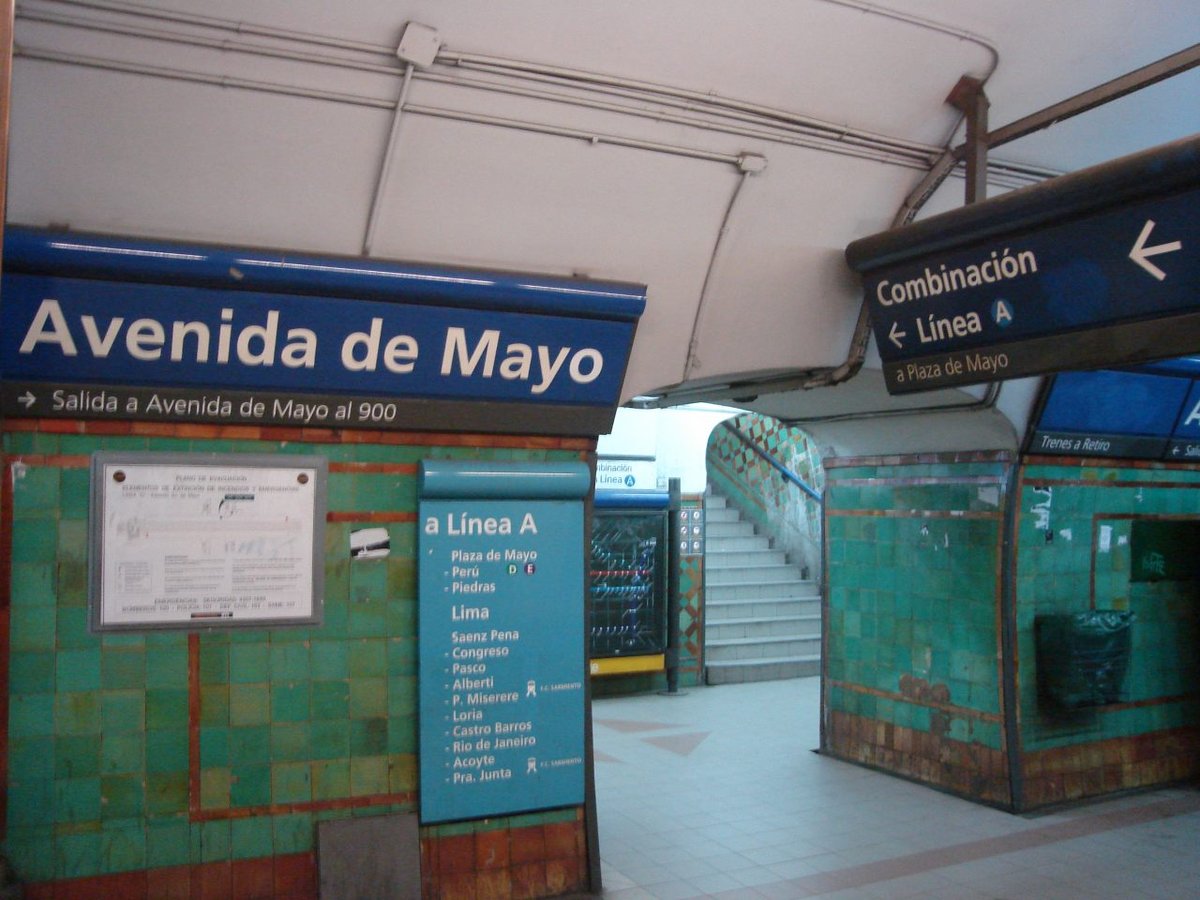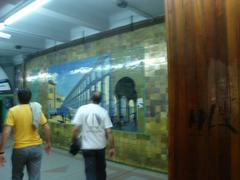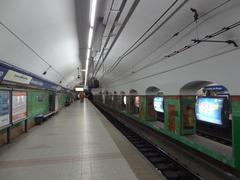
Avenida de Mayo Buenos Aires: Visiting Hours, Tickets, and Historical Sites Guide
Date: 15/06/2025
Introduction
Avenida de Mayo is one of Buenos Aires’ most iconic and historically significant boulevards, connecting the emblematic Plaza de Mayo with the Plaza del Congreso. Since its inauguration in 1894, the avenue has been at the heart of Argentina’s political, cultural, and architectural evolution. Inspired by the grand boulevards of Paris, Avenida de Mayo showcases a striking blend of Art Nouveau, Neoclassical, Belle Époque, and Art Deco styles, reflecting a period when Buenos Aires aspired to become a leading cosmopolitan capital.
This detailed guide provides insights into the avenue’s history, key landmarks, visiting hours, ticketing, accessibility, travel tips, and cultural highlights. Whether you’re a history enthusiast, architecture lover, or first-time visitor, this article will help you make the most of your experience along Avenida de Mayo. For further exploration, consult trusted sources like The Collector, Introducing Buenos Aires, and Vamos Spanish.
Table of Contents
- History and Urban Development
- Political and Social Significance
- Architectural and Cultural Landmarks
- Visiting Hours and Ticket Information
- Accessibility and Nearby Attractions
- Guided Tours and Experiences
- Travel Tips and Practical Advice
- Photographic Highlights
- Frequently Asked Questions (FAQ)
- References
History and Urban Development
Avenida de Mayo was conceived during Buenos Aires’ late-19th-century modernization, designed to create a direct, grand thoroughfare between two civic centers: Plaza de Mayo (home to the Casa Rosada) and Plaza del Congreso (site of the National Congress). Modeled after Parisian boulevards, its construction required significant urban restructuring, including the demolition of more than 60 older buildings (The Collector).
The avenue’s 1.5-kilometer stretch is characterized by broad sidewalks, tree-lined streets, and a harmonious blend of eclectic architectural styles. Its development marked a shift toward modernity for Buenos Aires, cementing its status as a leading urban center in South America (Introducing Buenos Aires).
Political and Social Significance
Strategically linking Argentina’s main government buildings, Avenida de Mayo has long been a stage for major political and social events. It has hosted presidential inaugurations, political demonstrations, and historic gatherings. The weekly marches of the Mothers of the Plaza de Mayo, advocating for human rights since the military dictatorship, continue to draw locals and tourists alike (History Hit; Wander Argentina).
Architectural and Cultural Landmarks
Palacio Barolo
A masterpiece of Art Nouveau and neo-Gothic design, Palacio Barolo (completed in 1923) was the tallest building in South America at the time. Its architecture is inspired by Dante’s “Divine Comedy,” with different floors representing Hell, Purgatory, and Paradise. The lighthouse at the top offers panoramic city views.
- Visiting Hours: Guided tours Tuesday to Sunday, 10:00 AM–5:00 PM.
- Tickets: Approx. ARS 900 for adults; discounts for students/seniors. Advance booking is recommended.
- Official Palacio Barolo Website
Café Tortoni
Founded in 1858, Café Tortoni is the city’s oldest café and a cherished cultural institution. It has hosted artists and intellectuals such as Jorge Luis Borges and Carlos Gardel. The Belle Époque interiors remain intact, and the café regularly hosts live tango and jazz shows.
- Opening Hours: Daily, 8:00 AM–midnight.
- Tickets: No entry fee; reservations advised for performances.
Edificio de la Inmobiliaria
This early 20th-century building is noted for its elaborate façade and twin domes, exemplifying the avenue’s eclectic architectural style (Introducing Buenos Aires).
Metropolitan Cathedral
Located near the avenue’s eastern end, this neoclassical landmark houses the mausoleum of General José de San Martín, Argentina’s independence hero.
- Visiting Hours: Daily, 9:00 AM–7:00 PM.
- Tickets: Free entry. (Miss Tourist)
Casa Rosada and Plaza de Mayo
The iconic pink presidential palace and its surrounding plaza are central to the country’s political life.
- Tours: Free, weekends/holidays, 10:00 AM–6:00 PM. Advance reservation and ID required.
- Casa Rosada Official Site
Cabildo de Buenos Aires
The colonial-era Cabildo offers museum exhibits on the May Revolution and Buenos Aires’ early history.
- Visiting Hours: Wednesday–Sunday, 10:30 AM–6:00 PM.
- Tickets: Free entry.
Visiting Hours and Ticket Information
- Avenida de Mayo: Open 24/7 as a public thoroughfare.
- Palacio Barolo: Guided tours Tuesday–Sunday, 10 AM–5 PM. Tickets required.
- Café Tortoni: Daily, 8 AM–midnight. No tickets needed; reservations for shows.
- Casa Rosada: Guided tours weekends/holidays, 10 AM–6 PM. Free; advance booking mandatory.
- Cabildo Museum: Wednesday–Sunday, 10:30 AM–6 PM. Free entry.
- Metropolitan Cathedral: Daily, 9 AM–7 PM. Free entry.
For up-to-date ticket information and bookings, consult official websites or the Buenos Aires tourism site.
Accessibility and Nearby Attractions
Avenida de Mayo is well-served by public transportation:
- Subte (Metro): Line A (stations: Plaza de Mayo, Perú, Piedras, Sáenz Peña, Congreso)
- Buses: Numerous lines run along or cross the avenue.
- Taxis/Rideshare: Widely available.
The avenue’s sidewalks are generally accessible, though some historic buildings may have limited wheelchair access. Nearby attractions include:
- Avenida 9 de Julio & Obelisk: The world’s widest avenue intersects Avenida de Mayo.
- San Telmo: Historic neighborhood with tango venues and antique markets.
- Microcentro: The city’s bustling downtown district.
Guided Tours and Experiences
- Walking Tours: The Buenos Aires city tourist board offers free walking tours of Plaza de Mayo and Avenida de Mayo every Monday (English at 11 AM, Spanish at 3 PM).
- Palacio Barolo Tours: Available in several languages, including sunset tours for city views.
- Bike Tours: Cover Avenida de Mayo and surrounding neighborhoods.
- Tango Shows: Café Tortoni hosts popular performances; booking ahead is advised.
Travel Tips and Practical Advice
- Language: Spanish is the official language; English is spoken in tourist areas.
- Currency: Argentine peso (ARS). Credit cards accepted, but carry cash for small purchases.
- Best Visiting Times: Daytime is ideal for architectural tours; evenings offer a charming atmosphere.
- Dining: Sample Argentine cuisine at cafés and parrillas along the avenue.
- Safety: Avenida de Mayo is safe during the day; exercise caution during large protests.
- Dress Code: Casual, but locals dress smartly in cafés and restaurants.
- Tipping: 10% is standard in restaurants and cafés.
Photographic Highlights
- Casa Rosada at sunrise or sunset
- Palacio Barolo’s illuminated dome
- Café Tortoni interiors
- Avenida de Mayo’s tree-lined boulevard
- Obelisk at Avenida 9 de Julio
For virtual tours and downloadable maps, visit the official Buenos Aires tourism website.
Frequently Asked Questions (FAQ)
Q: Is Avenida de Mayo free to visit?
A: Yes, the avenue is public and accessible 24/7. Some landmarks require tickets or advance reservations.
Q: What are the best hours to visit?
A: Daytime (9 AM–6 PM) is ideal for landmark visits and photography.
Q: Are guided tours available?
A: Yes, both free and paid guided tours are widely available.
Q: Is the area accessible for visitors with disabilities?
A: Sidewalks are generally accessible, but some historic buildings may have limitations. Check in advance for specific needs.
Q: Is Avenida de Mayo safe?
A: It is safe during the day; standard urban precautions are recommended.
References
- The Collector
- Introducing Buenos Aires
- Vamos Spanish
- Official Buenos Aires Tourism
- Casa Rosada Official Site
- History Hit
- Wander Argentina
- Miss Tourist
Plan your visit today, download the Audiala app for guided tours, and follow us on social media to stay updated on events and insider tips!
































































































































































